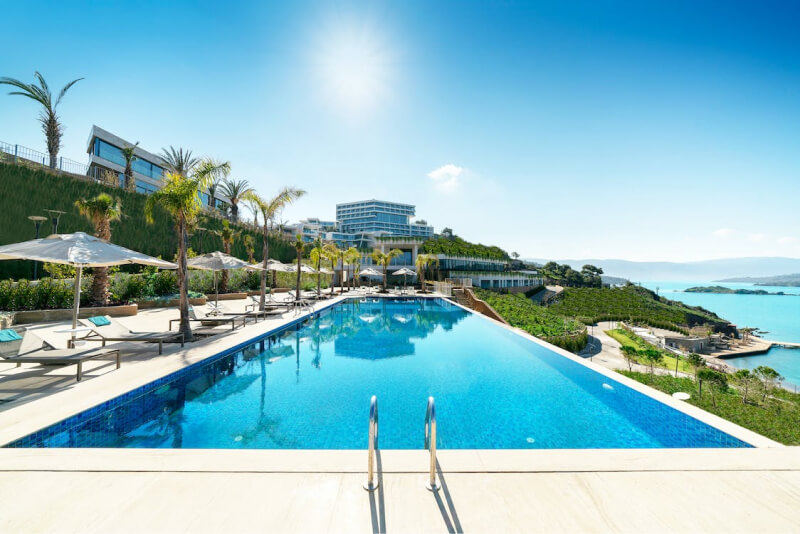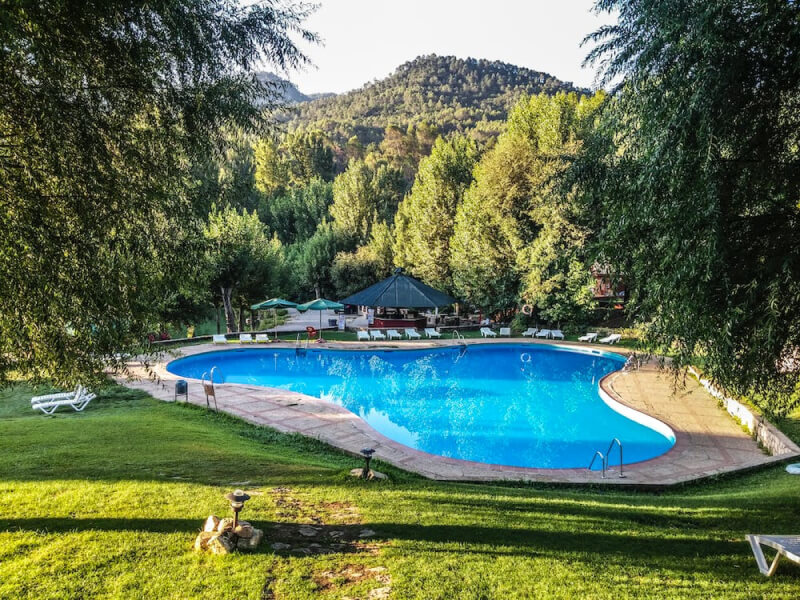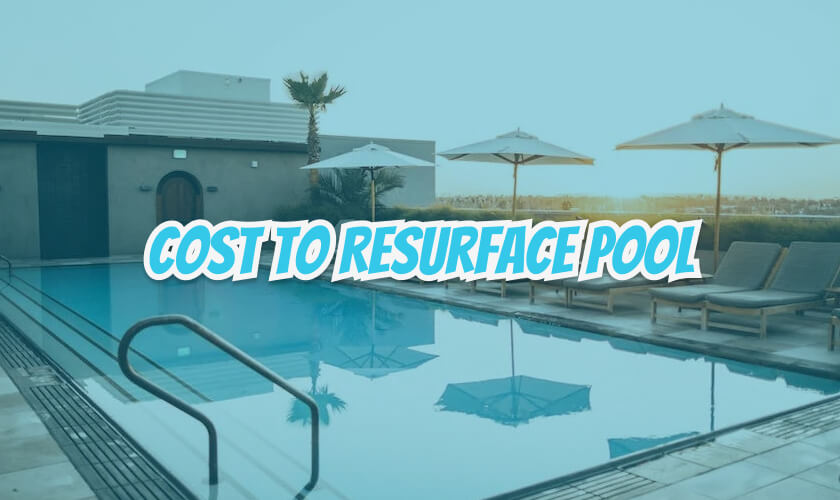Are you considering resurfacing your pool? If so, you’re probably wondering about the cost involved. Well, you’ve come to the right place! In this article, we’ll break down the factors that influence the cost to resurface a pool and give you a better idea of what to expect.
The cost to resurface a pool can vary widely depending on several factors. First and foremost is the size of your pool, as larger pools will naturally require more materials and labor. Additionally, the type of surface you choose will affect the cost. Options range from traditional plaster to more durable finishes like pebble or quartz.
Other factors to consider include the condition of your existing pool surface, any necessary repairs or upgrades, and your location, as labor and material costs can vary from one area to another. By understanding these factors, you’ll be better equipped to make an informed decision about resurfacing your pool. So, let’s dive in and explore the cost to resurface a pool!
Factors Affecting the Cost to Resurface a Pool

There are several factors that can influence the cost to resurface a pool. Understanding these factors will help you estimate the budget required for this project. Let’s take a look at some of the key considerations:
Pool Size
The size of your pool plays a significant role in determining the cost of resurfacing. Larger pools require more materials and labor, which will increase the overall expense.
Pool Type
Different types of pools have varying resurfacing requirements. For instance, concrete pools may need more preparation work, such as patching and leveling, compared to fiberglass or vinyl pools.
Surface Material
The material you choose for resurfacing will affect the cost. Common options include plaster, pebble, and tiles. Each material has its own price range, durability, and aesthetic appeal.
Design Complexity
If your pool has intricate designs or features like steps, tanning ledges, or waterfalls, it may require specialized skills and additional labor, which can impact the cost.
Current Condition
The condition of your pool’s existing surface can affect the cost as well. Pools with extensive damage or cracks may require more extensive repairs before resurfacing, adding to the overall expense.
Read Also: Pool Salt Calculator: Easily Determine How Much Salt You Need for Your Pool
Geographical Location
The cost of labor and materials can vary depending on your location. Areas with a higher cost of living or limited pool resurfacing professionals may have higher prices.
Additional Upgrades
If you plan to include any additional upgrades during the resurfacing process, such as adding new lighting, replacing old equipment, or incorporating water features, these will contribute to the overall cost.
It’s important to note that the cost to resurface a pool can vary significantly based on these factors. To get an accurate estimate, it’s advisable to consult with a professional pool contractor who can assess your specific requirements and provide a customized quote.
| Factors Affecting Cost to Resurface a Pool |
|---|
| Pool Size |
| Pool Type |
| Surface Material |
| Design Complexity |
| Current Condition |
| Geographical Location |
| Additional Upgrades |
Remember, every pool is unique, and understanding these factors will help you plan and budget effectively for your pool resurfacing project.
Different Pool Resurfacing Options

When it comes to resurfacing your pool, there are several options available to consider. Each option comes with its own benefits and costs, so it’s important to weigh them carefully before making a decision.
- Plaster: Plaster is a popular choice for pool resurfacing due to its affordability and versatility. It provides a smooth and durable finish, giving your pool a fresh new look. However, keep in mind that plaster may require more frequent maintenance and can be prone to staining over time.
- Pebble Tec: If you’re looking for a more luxurious and long-lasting option, Pebble Tec might be the way to go. Made from a mix of pebbles and cement, this resurfacing material offers a unique, textured finish that not only enhances the beauty of your pool but also provides added durability. Although it may come at a higher cost, Pebble Tec is known for its longevity and resistance to chemicals and stains.
- Quartz: Quartz is another popular choice for pool resurfacing, known for its durability and low maintenance requirements. It consists of a blend of quartz crystals and colored ceramic-coated aggregate, providing a smooth and vibrant finish to your pool. Quartz is highly resistant to chemicals and staining, making it a great option for those seeking a hassle-free resurfacing solution.
- Tile: If you prefer a more customizable and decorative finish, consider using tiles for your pool resurfacing. Tiles offer a wide range of colors, patterns, and designs, allowing you to create a unique look that matches your style. While tile resurfacing may require a higher upfront investment, it provides excellent durability and can withstand harsh weather conditions.
Here’s a comparison of some key factors to consider:
| Resurfacing Option | Cost | Durability | Maintenance |
|---|---|---|---|
| Plaster | $3-$5 | Medium | High |
| Pebble Tec | $5-$10 | High | Low |
| Quartz | $10-$20 | High | Low |
| Tile | $20-$30 | High | Medium |
Remember, the cost to resurface your pool will depend on factors such as the size of your pool, location, and the specific materials chosen. It’s always a good idea to consult with a professional pool contractor to get an accurate estimate and guidance on the best option for your pool’s needs.
Read Also: Pool Heater Cost: What You Need to Know Before Investing
Pros and Cons of Each Resurfacing Option

When it comes to resurfacing your pool, there are several options available, each with its own set of pros and cons. Let’s take a closer look at the different options and what you need to consider before making a decision.
1. Plaster
- Pros:
- Affordable option for pool resurfacing.
- Smooth and aesthetically pleasing finish.
- Can last for 10-15 years with proper maintenance.
- Cons:
- Prone to staining and discoloration over time.
- Requires regular chemical balance and maintenance.
- May need to be resurfaced more frequently compared to other options.
2. Pebble Aggregate
- Pros:
- Durable and long-lasting surface.
- Provides a unique and natural look.
- Resistant to stains and chemicals.
- Can last up to 20 years with proper care.
- Cons:
- More expensive than plaster.
- Rougher texture may not be suitable for everyone.
- Requires occasional acid washing to maintain appearance.
3. Tile
- Pros:
- Highly customizable with various colors and patterns.
- Resistant to stains, chemicals, and UV damage.
- Easy to clean and maintain.
- Cons:
- Costlier option compared to plaster and pebble aggregate.
- Grout lines may accumulate dirt and require regular cleaning.
- Can be a time-consuming installation process.
4. Fiberglass
- Pros:
- Smooth and non-porous surface.
- Resistant to stains, algae, and chemicals.
- Low maintenance and long-lasting.
- Can last for 25 years or more.
- Cons:
- Expensive upfront cost.
- Limited customization options.
- Requires professional installation.
Before deciding which resurfacing option is best for your pool, consider factors such as your budget, desired aesthetic, and long-term maintenance requirements. Each option has its own advantages and disadvantages, so weigh them carefully to make an informed decision.
| Resurfacing Option | Pros | Cons |
|---|---|---|
| Plaster | – Affordable option | – Prone to staining and discoloration |
| – Smooth and aesthetically pleasing | – Requires regular maintenance | |
| – Can last 10-15 years with care | – May need more frequent resurfacing | |
| Pebble Aggregate | – Durable and long-lasting surface | – More expensive than plaster |
| – Unique and natural look | – Rougher texture may not be suitable for everyone | |
| – Resistant to stains and chemicals | – Requires occasional acid washing | |
| Tile | – Highly customizable | – Costlier compared to plaster and pebble aggregate |
| – Resistant to stains and chemicals | – Grout lines may accumulate dirt | |
| – Easy to clean and maintain | – Time-consuming installation process | |
| Fiberglass | – Smooth and non-porous surface | – Expensive upfront cost |
| – Resistant to stains and chemicals | – Limited customization options | |
| – Low maintenance and long-lasting | – Requires professional installation |
In the end, the best resurfacing option for your pool will depend on your preferences, budget, and how much time you can dedicate to maintenance.
Read Also: Heated Saltwater Pool: Everything You Need to Know!
Average Costs for Pool Resurfacing

When it comes to pool resurfacing, the cost can vary depending on various factors such as the size of the pool, the type of material used, and the condition of the existing surface. Here, we will break down the average costs associated with pool resurfacing to give you a better idea of what to expect.
Materials and Labor
The cost of materials and labor is one of the main considerations when resurfacing a pool. On average, you can expect to pay between $3,500 and $7,500 for a standard-sized pool (around 12′ x 24′). This estimate includes the cost of materials such as plaster, pebble, or tile, as well as the labor required to complete the resurfacing job.
Additional Factors
While the size of the pool is a significant factor, there are additional considerations that can affect the overall cost of pool resurfacing. These factors include:
- Pool shape: Pools with intricate shapes or curves may require more labor and materials, resulting in higher costs.
- Existing damage: If your pool has extensive damage, such as cracks or leaks, the cost of repairs before resurfacing can increase the overall expense.
- Extras: Additional features like waterline tiles, decorative elements, or special finishes can add to the total cost.
Comparing Different Resurfacing Options
There are several resurfacing materials available, each with its own cost range. Here’s an overview of some popular options:
| Resurfacing Material | Average Cost per Square Foot |
|---|---|
| Plaster | $3 – $5 |
| Pebble | $5 – $10 |
| Tile | $20 – $30 |
It’s important to note that these average costs are just estimates and can vary depending on your location, the contractor you choose, and any additional customization you require.
Planning Your Budget
When planning your pool resurfacing project, it’s crucial to consider the average costs discussed above. It’s recommended to obtain multiple quotes from reputable contractors to compare prices and ensure you get the best value for your money. Additionally, don’t forget to account for any potential extra expenses or unforeseen repairs that may arise during the process.
By understanding the average costs associated with pool resurfacing, you can make an informed decision and budget accordingly. Remember to consider your specific needs and preferences to choose the resurfacing material that best suits your pool and budget.
How to Choose the Right Pool Resurfacing Option

When it comes to resurfacing your pool, choosing the right option is crucial. Here are a few factors to consider before making a decision:
Budget
Start by determining how much you are willing to spend on pool resurfacing. The cost can vary depending on the material you choose, so it’s essential to have a clear idea of your budget.
Durability
Consider the longevity of the resurfacing option. You want to invest in a material that will withstand the test of time and require minimal maintenance. Some popular options known for their durability include pebble finishes, fiberglass, and plaster.
Aesthetics
The appearance of your pool is important, so think about the desired look you want to achieve. Different resurfacing materials offer various color and texture options. Take into account the overall style of your outdoor space and choose a finish that complements it.
Climate
Consider the climate in your area. If you live in an area with freezing temperatures, you’ll want to choose a resurfacing material that can handle the expansion and contraction caused by freeze-thaw cycles. Additionally, if you experience intense sun exposure, opt for a material that is resistant to fading and UV damage.
Maintenance
Think about the level of maintenance required for each resurfacing option. Some materials may require regular cleaning or special care to maintain their appearance. Assess how much time and effort you are willing to put into maintaining your pool’s surface.
Expertise
Look for a reputable pool resurfacing contractor with experience in the specific material you choose. Proper installation is crucial for the longevity and quality of the resurfacing job. Seek recommendations, read reviews, and ask for examples of their previous work.
Remember, each pool is unique, and what works for one may not work for another. Take the time to evaluate your specific needs and consult with professionals to find the best resurfacing option for your pool. With the right choice, you can transform your pool and enjoy it for years to come.
Read Also: A Guide to Store Your Pool Chemicals Properly
Conclusion
After exploring the cost to resurface a pool, it’s clear that this investment can significantly improve the appearance, functionality, and longevity of your pool. While the exact cost will vary depending on various factors, such as pool size, materials used, and labor costs in your area, it’s essential to consider the long-term benefits and value it brings to your property.
Here are the key takeaways from our analysis:
- Resurfacing a pool is a worthwhile investment that can enhance the overall aesthetics of your pool area.
- It can extend the lifespan of your pool by addressing cracks, leaks, and surface deterioration.
- The cost of resurfacing typically ranges between $3,500 and $8,000, with an average cost of around $5,500. However, keep in mind that these figures are estimates and may vary.
- Factors affecting the cost include pool size, type of pool finish, additional repairs or upgrades required, and labor costs in your region.
- While resurfacing may seem expensive upfront, it can save you money in the long run by preventing further damage and future repairs.
- Regular maintenance and proper pool care can help prolong the lifespan of the resurfaced pool and maximize your investment.
Remember, it’s crucial to consult with professional pool contractors in your area to get accurate cost estimates tailored to your specific pool and needs. They can provide expert advice, suggest suitable finishes, and guide you through the resurfacing process.
Investing in the resurfacing of your pool not only enhances its appearance but also ensures a safer and more enjoyable swimming experience for years to come. So, take the plunge and give your pool the makeover it deserves!
